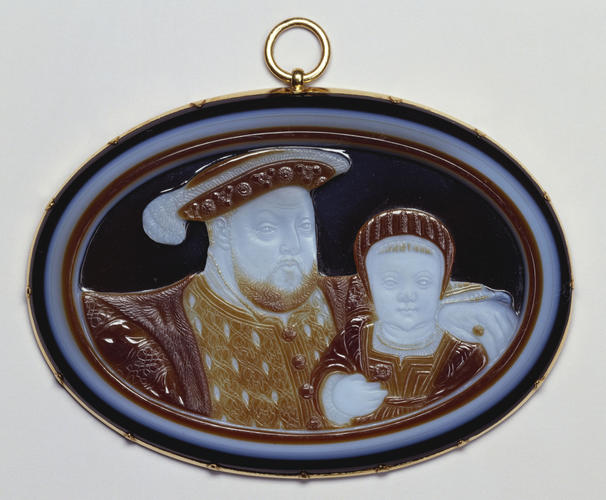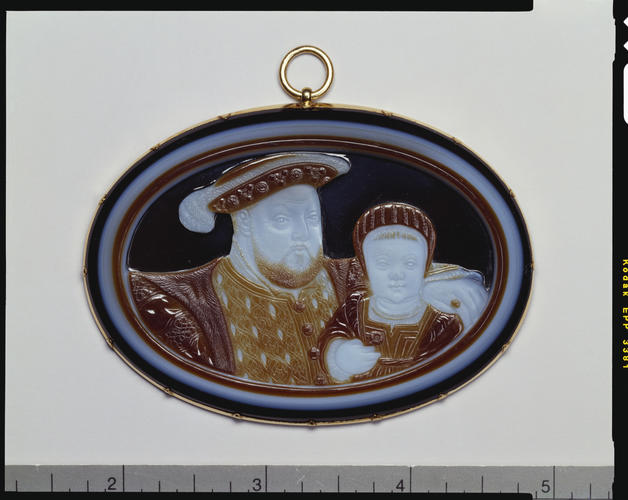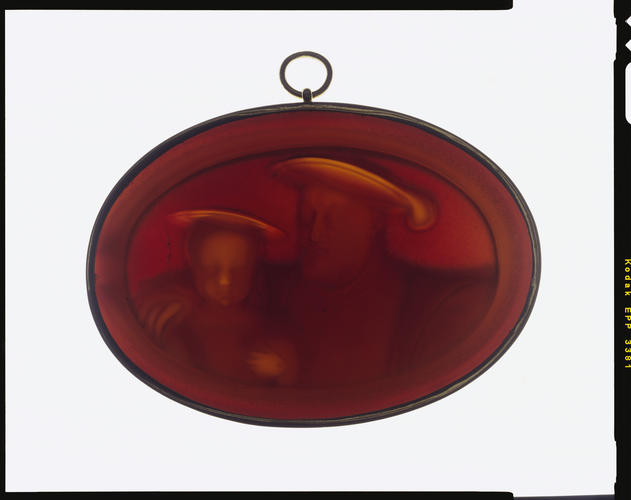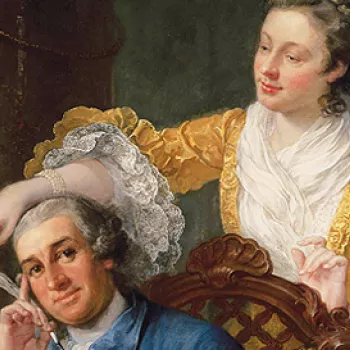Henry VIII and Prince Edward 18th c.
Sardonyx: reddish-brown, white, visually black ground; open gold mount with claw settings; suspension loop and ring | 5.7 x 7.8 cm (cameo) | RCIN 65189




-
Obverse: busts of Henry VIII (1491-1547) and the young Prince Edward (1537-53). The King is in three-quarter profile to the right and the Prince is seen frontally. The King places his left hand on his son’s shoulder and the Prince holds a flower in his right hand. Their skin is rendered matt and the rest, including the eyes, is polished. The relief is flat and flush with the surrounding raised edge and bevelled border. The layering of the stone is visible from the side.
Reverse: a mirror image of the obverse, rudimentarily repeated in intaglio; the Prince wears a cap over his bonnet.
There are no double portraits of Henry VIII and Prince Edward with which to compare this image. The group appears to combine two independent portraits based on prototypes by Hans Holbein the Younger (1497/8-1543). The King in three-quarter profile is seen in Holbein’s cartoon for the Whitehall Mural in the National Portrait Gallery, London and also in a portrait in the Thyssen-Bornemisza collection, Madrid. However, in both of the above the King’s dress differs insofar as the doublet has pairs of buttons and the shirt has an embroidered neckband. The closest parallels to the King’s dress as seen in the cameo are found in replicas of the lost Whitehall Mural; the anonymous late 16th century copy in the Royal Collection includes the same single row of jewelled buttons, with three rows of slashes on either side and the bent-over shirt collar. The most remarkable difference in the cameo is the lack of the great collar which is such a notable element in all the paintings.
The image of Prince Edward is derived from the portrait by Holbein in the National Gallery of Art, Washington D.C. That portrait includes the cap, as on the intaglio reverse. The pose, however, is slightly different: his right hand is outstretched and the left holds a rattle. A preliminary drawing for the portrait survives in the Royal Collection. The left hand of the King rests awkwardly on the Prince’s shoulder and appears disconnected from the body.
A cameo of Prince Edward, based on the same Holbein drawing and similar in treatment, is in the Devonshire collection at Chatsworth House. It also has an intaglio on the reverse. George Vertue recorded and drew a cameo of Henry VIII in profile with an intaglio on the reverse ‘sett in a gold hoop or swivell to hold it as at Sealing’.
During a recent technical examination of the gem it was noticed that when it was strongly lit from behind the images on the obverse and reverse combine to produce a single image of greater depth and subtlety.
The cameo could be seen as a piece of political or dynastic propaganda, executed between 1539/40 (the date of the Holbein portraits) and 1544 (when the Princesses Mary and Elizabeth were granted the right of succession). Richard Astill, stone-engraver to Henry VIII, has been proposed as its author. However, he remains a shadowy figure and no certain work from his hand has yet been identified.
Doubt is further cast over a contemporary attribution. It is curious that the King has been portrayed without his splendid collar ‘of such Balistes and Perle that few men ever saw the lyke’. The position of the King’s hand looks unnatural and seems to indicate a degree of paternal affection out of keeping with the 16th century, a period when gestures had a symbolic rather than a sentimental meaning. Where a somewhat similar pose occurs, for example in the anonymous painting of the family of Henry VIII, c. 1545, the intention is obviously to underline the succession.
It is also difficult to imagine that Elizabeth I would have commissioned the cameo. There would have been no reason for her to want a loving portrait of her dead father and brother once she herself was safely on the throne.
The device of superimposing two ‘flat’ images may also account for the curiously unmodelled execution, which points to a derivative commission not contemporary with the sitters. This, together with the technique (which has no parallel in documented 16th century pieces), suggests a renewed analysis of dating. The most likely period would therefore be in the first half of the 18th century when there was a substantial revival of interest in the Tudor period, starting with the reissue of Edmund Spenser’s Faerie Queen in 1725 and culminating with Peter Scheemaker’s monument to Shakespeare of 1740 in Westminster Abbey.
The only known fact relating to the early history of the gem dates from 1763, when it was seen by Horace Walpole at Kensington Palace and noted in his list of ‘Other pictures & curiosities’ of the late Queen Caroline, consort of George II, at Kensington Palace: ‘Hen. 8 and Pr. Edw. cameo on one side, intaglia on the other’. It was delivered, together with other ‘curiosities’ to her grandson, George III, on 22 March 1764: ‘King Henry 8th with Prince Edward, on Sardonyx, cameo on one side, and intaglia on the other.
This reference not only gives an obvious terminus ante quem; it also connects the cameo with Queen Caroline (possibly bringing the terminus ante quem to 1737, the year of her death). The Queen had reunited early royal portraits, including Remigius van Leemput’s copy of Holbein’s Whitehall Mural, and displayed them in her closet in Kensington Palace, where George Vertue saw them in 1734. Vertue’s watercolour copy of the Leemput is signed and dated 1737 and was subsequently engraved. He also saw Holbein’s portrait drawings of members of Henry VIII’s court in 1739 and was authorised to copy them in 1743. In 1731 Jean Dassier began the series of medals of English monarchs (including Henry VIII) that was to be struck repeatedly in the 1730s. The likeness of Henry VIII on the cameo is slightly different from that found on these medals and differs from other 18th century medallic versions of the King. It would seem that the cameo pre-dates all these popular medals.
It should also be noted that by the early 18th century gem-engravers of renown were working in England, for example Charles Christian Reisen (1680-1725), who was recorded by Vertue; and at the same time significant gem-collectors began to emerge, especially following the foundation of the Society of Dilettanti in 1734.
A cast of the cameo, which includes the reverse intaglio, is in the Walters Art Museum, Baltimore. It is listed as a cast of the Royal Collection gem and is contained in a box from the Royal goldsmiths, Rundell, Bridge & Rundell.
Text adapted from Ancient and Modern Gems and Jewels in the Collection of Her Majesty The Queen, London, 2008Provenance
Probably Queen Caroline and first documented in the Royal Collection in 1763. Seen by Horace Walpole at Kensington Palace: 'Hen. 8 and Pr. Edw. cameo on one side, intaglia on the other'. It was delivered, together with the other 'curiosities' to George III on 22 March 1764: 'King Henry 8th with Prince Edward, ... on Sardonyx, cameo on one side, and intaglia on the other; by Valerio Vicentino' (RA GEO/Add.Ms.16).
-
Creator(s)
Acquirer(s)
-
Medium and techniques
Sardonyx: reddish-brown, white, visually black ground; open gold mount with claw settings; suspension loop and ring
Measurements
5.7 x 7.8 cm (cameo)
Category








